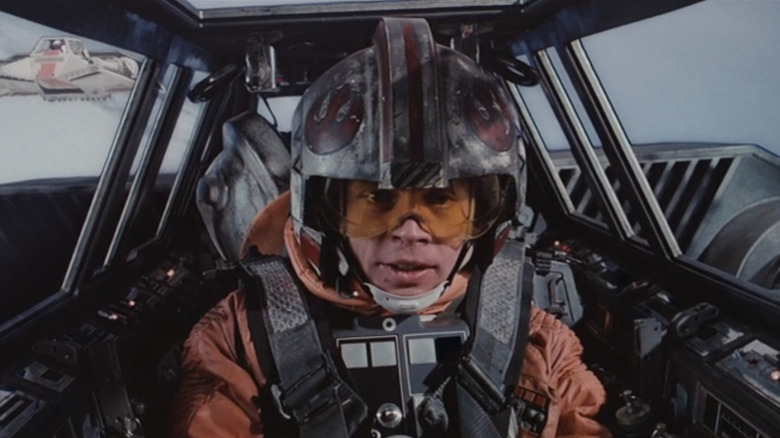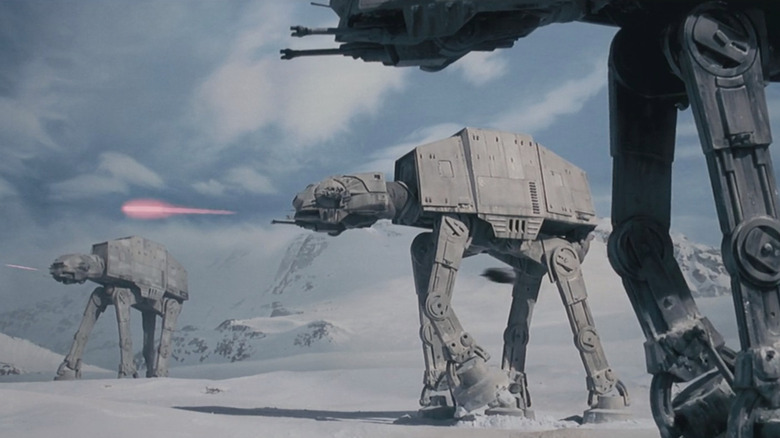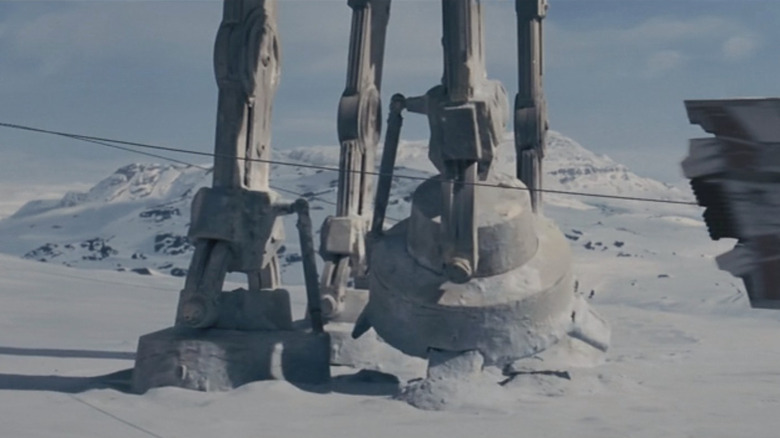George Lucas Left A Lot Of Room For Interpretation When Writing Star Wars' Battle Of Hoth
Many fans of the galaxy far, far away consider "Star Wars: Episode V — The Empire Strikes Back," directed by Irvin Kershner, to be the best out of all the "Star Wars" films. It's one of the rare cases where a sequel is better than even the original work. While "A New Hope" was our introduction to Luke Skywalker (Mark Hamill), Princess Leia (Carrie Fisher), Han Solo (Harrison Ford), and Darth Vader (David Prowse, voiced by James Earl Jones), "Empire" really went deep into their stories, with revelations about the Skywalker family, the loss of Luke's hand, the developing relationship between Leia and Han, and a real test of Luke's Force abilities. It also featured one of the best set-pieces in film history — the battle on the ice planet Hoth.
Three years after Luke and the Rebel Alliance destroyed the first Death Star, the Imperial fleet uses probe droids to search the galaxy for their new hideout. One of them finds it on Hoth after Luke survives a wampa attack and a night in a tauntaun carcass. The Empire swoops in with AT-AT walkers and heavy weaponry, beginning the Battle of Hoth. Though the Rebels use some great techniques, like wrapping a giant cord around the legs of the AT-ATs, ultimately, they're forced to flee. Having the good guys lose a considerable base site was a bold move, and the fight itself is visually stunning, even with the primitive visual effects that were available at the time.
In a 2020 feature on StarWars.com, visual effects art director Joe Johnston (director of "Jumanji," "Honey, I Shrunk the Kids," and "Captain America: The First Avenger") spoke about the massive action scene and how he was given a lot of freedom to create the look of the Battle of Hoth.
The Battle of Hoth wasn't written into the initial script
Though Leigh Brackett wrote the first draft of the script, followed by one from Lucas and then another by Lawrence Kasdan, Lucas left the details of the battle fairly open, something he often did, according to Johnston in the StarWars.com interview. He says:
"[T]here was no written [Battle of Hoth] sequence in the first script that I read, and this was typical of the way George would do the action sequences. There would just be a blank, and he would say something — the example I remember is from '[Return of the] Jedi,' where the script said, 'Luke and Leia jump on a speeder bike and race off into the woods.' And then there'd be a blank slot. [Laughs] I think it was something like, 'The Imperial trooper crashes into a tree and they run off into the forest.' He would basically leave all the action out knowing that we were going to be using storyboards and models and whatever technique we could. We would figure out what the action sequence was."
It's relatively common for some writers to leave the action sequences either to a storyboard artist or a director if that's not their forte. Considering how great the Battle of Hoth is, it worked out beautifully. For something like this, in a time where you couldn't just use CGI to create everything on the screen, this sequence is a testament to the incredible skill and imagination of Johnston and the team.
'We had a lot of freedom'
Johnston says, "We had a lot of freedom" with the production and that Lucas wanted them to "explore the best ways to figure out the action." He explains the process for that sequence specifically:
"I just remember him saying, 'Just come up with shots. They don't even have to be connected. Just come up with cool shots that would show some ideas about how this ragtag band of rebels on this snow planet defend their base from an overwhelming force of Imperial soldiers.' At that point we hadn't designed the walkers yet. We knew they were going to have some kind of mechanized equipment, but it wasn't specifically a walker."
The silhouette of the AT-AT walkers is immediately recognizable as coming from "Star Wars" and looks like nothing else out there (other than a whippet), and the design naturally lends itself to the clever cable technique. Coming up with the shots wasn't a quick process, according to Johnston who says:
"I must have spent a month or longer just drawing shots. I sort of did them in storyboard form, because I was thinking I'll be able to connect some of these eventually and make sequences out of them, but I would draw a stack of interesting angles and shots and things. George would come in and he'd go through them and say, 'Yeah, that's cool, let's save that one.' Other ones he said, 'I don't know how to use that.'"
Lucas clearly trusted his team (with very good reason) to take his ideas and turn them into a visual narrative. Whatever you think of the "Star Wars" franchise, this scene is visually iconic. May be worth a rewatch of "The Empire Strikes Back" this weekend. It's currently streaming on Disney+.


